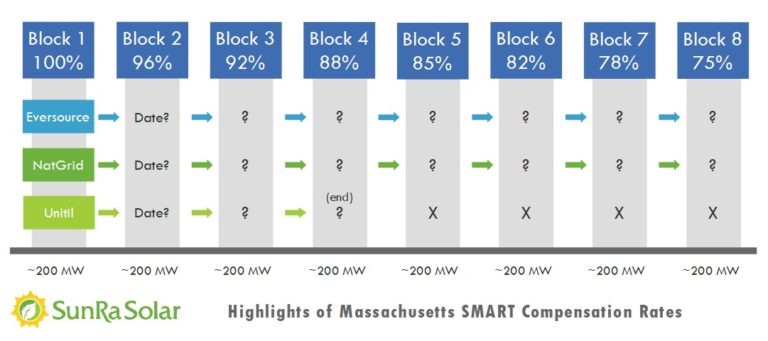Solar News & Information
The Solar Massachusetts Renewable Target Incentive
February 10, 2019
Defining the SMART Program for Solar Homeowners
As with most renewable energy programs designed to make investment and adoption more possible, the state was required to define rules and guidelines for everyone. From utilities to municipal authorities, businesses to homeowners, the program must work to provide a path for buyers of the largest MW-sized systems down to the 5 kW or 10 kW rooftop system for the average home.
For SunRa Solar customers, here is a condensed explanation of the key elements that will impact your solar energy investment.
Three Massachusetts utilities are required to participate.
The DOER enforces specific guidelines for each utility across a range of system capacities. For almost all homeowners, the ideal system will be smaller than 25 kW, the cut off capacity for the first level in the guidelines.
Essentially the SMART program compensates the solar energy system owners for unused generated solar power that is returned to the network or grid.
This helps the homeowner derive two levels of savings:
Reduced payments to the utility
Solar energy system output covers all or a portion of homeowner needs.
During periods where a homeowner is using more power than the solar energy system can provide, the savings are still substantial. The household is avoiding payments to the utility for every bit of energy the solar system generates.
Whenever the system generates more power than can be used, special meters track the flow from the home back to the grid. There are no power charges accruing during these times.
As an example, a 10 kW system on a typical Massachusetts home may save approximately $2,500 a year in avoided purchases. Savings depend on which of the utilities provides power and the local rates.
Compensation for excess solar power generated during a period (SMART)
Solar energy system output is periodically greater than homeowner needs.
Any time the system generates more power than can be used, and the special meters track the excess, additional credits are accruing. The SMART program defines a specific value for each excess unit, in kWh. That value is declining over time. See How Compensation Works below for more detail.
Your SMART compensation depends significantly on the your energy efficiency, system design, your utility, and the timing of your solar investment.
Peak solar season occurs during the summer, when the sun is more direct and the days are longer. Depending on the solar energy system design, it is very common for there to be excess solar power in the middle of many days during this period. How these accrued credits are valued and compensated depend on a few factors.
How Compensation Works
The 1.6 GW target was segregated into 8 individual and nearly equal blocks of approximately 200 MW. The level of compensation declines by a predictable amount – 4% – in each successive block. Because of the differences in the sales of power for each of the 3 utilities, a different portion of each block of 200MW is assigned to them. This is based on a calculation tied to their historical capacity, or sales.
The most important points about the SMART compensation schedule:
- The blocks are limited by capacity, not generation. Each system is locked into a block when the application submitted by the installer is approved.
- The schedule requires a 4% decrease in rate when transitioning to each subsequent block.
- Each utility has a unique limit within each block based on capacity. In general this results in Eversource having the largest portion, followed closely by National Grid. Unitil’s portion is significantly smaller.
- Therefore, each utility arrives at its limit independently. It is possible and likely that each utility will be paying within a different block at any given time.
This mix of factors requires a thorough but quick look at each site’s specifics. But, it also complicates the matter for many who are investigating their solar savings potential.
We’ve reduced the essence of this to a simple visual to help understand the impact of the timing for an investment. Suggesting a homeowner buy a solar energy system today isn’t purely a sales tactic. It is an earnest message to maximize savings.
This illustration highlights the most important realities about the SMART compensation schedule:
The full (100%) compensation goes to the earliest solar adopters.
Each utility independently satisfies their capacity limits within each Block.
Predicting each utility’s transition to the next Block is a challenge.
SunRa Solar Committment
Any home that is suitable for solar can save thousands. In addition to avoiding paying for some or all of your power, a buyer will see extra financial benefit thanks to the new and more predictable SMART compensation program.
This is a reason SunRa Solar offers easy and no obligation evaluations for homeowners.
- The company can quickly review your home’s suitability.
- There will be more timely and accurate insight into the current status of each utility within the SMART Block framework.
- Therefore an accurate investment and savings estimate can be provided.
Contact Us with questions or to see exactly how solar power will work for YOUR home, saving you thousands. It’s a free evaluation with absolutely no obligation.




